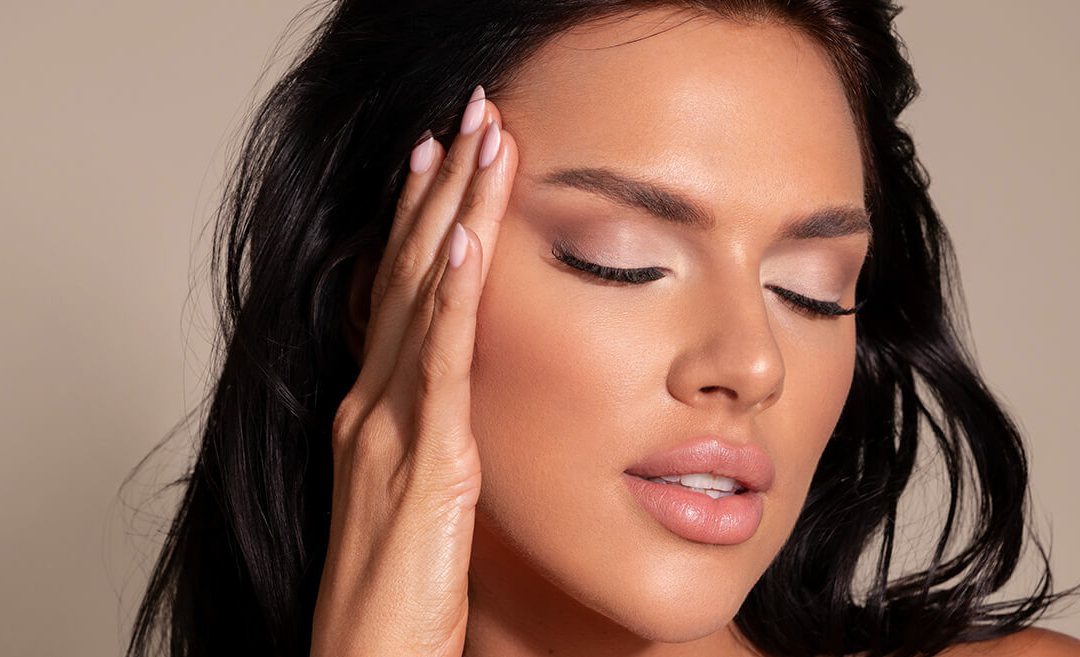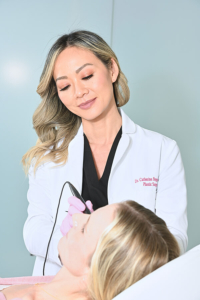The term “hooded eyes” refers to the condition when excess skin droops from the brow bone over the top part of the eye. This genetic trait is common in people of all ages and typically affects both eyes.
Aging can cause hooded eyes to worsen. Not only can it be a cosmetic concern, but the excess skin over the eye can also cause issues that interfere with a person’s vision because the skin hangs so low.
Characteristics of Hooded Eyes
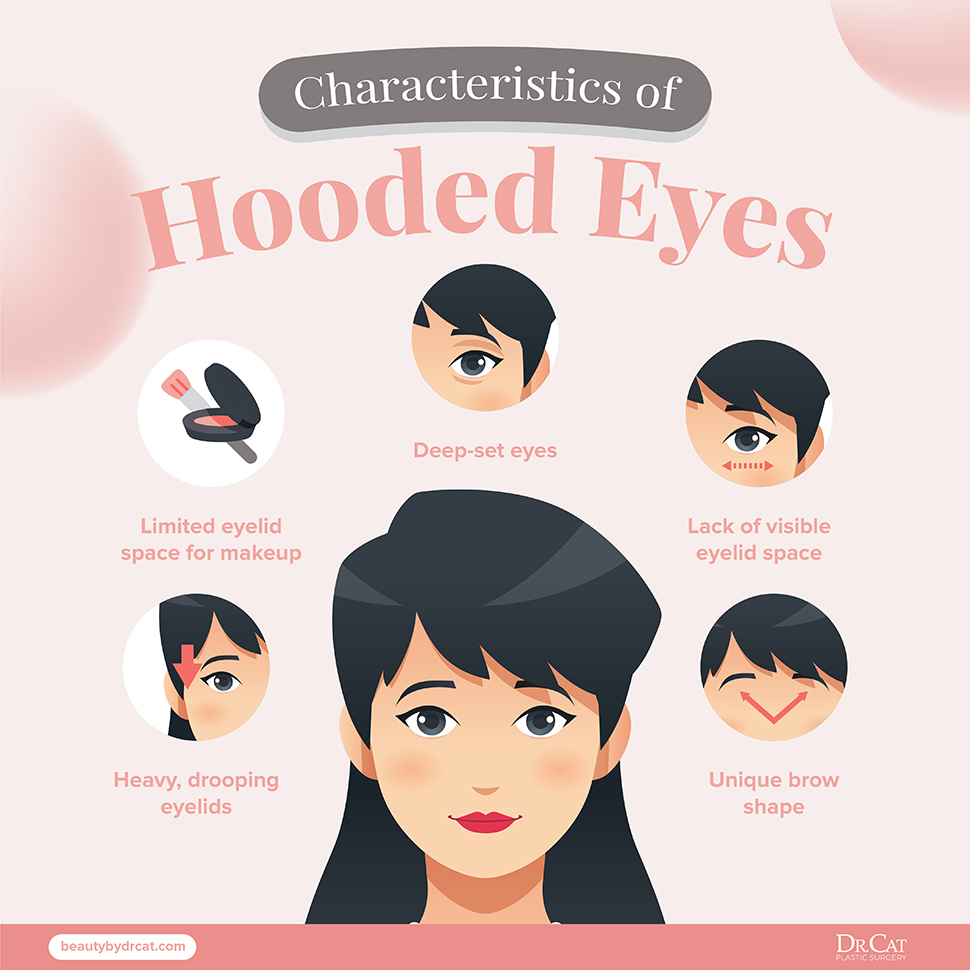
People with hooded eyes have heavy brow bones and deep-set creases. The skin hangs down low enough that the creases are covered up, causing the upper eyelids to look smaller.
If you look in the mirror and keep your eyes open, you should be able to see the crease. You have hooded eyes if the crease isn’t visible because it is covered by excess skin.
Another way to tell if your eyes are hooded is by looking at the eyelash line. Do you see the skin below your brow touching the lash line? Then it is a sign that you have hooded eyes.
Is There a Difference Between Hooded Eyes and Droopy Eyes?
Some people use the terms interchangeably: hooded eyes and droopy eyes. But there is a distinct difference between these two conditions.
Hooded eyes occur because of their natural eye shape due to prominent brow bones and larger creases in the eyelid. This genetic condition can affect people of all ages, although the risk of hooded eyes increases with age. Most of the time, hooded eyes don’t affect vision.
On the other hand, droopy eyes happen in older adults when the skin starts sagging above the eye. Eventually, sagging skin can drop so low that it causes vision problems. Droopy eyes can make it difficult to open the eyes all the way.
Hooded eyes don’t necessarily fall in the category of droopy eyes. But some hooded eyes may have a droopy appearance.
Most Common Causes of Hooded Eyes
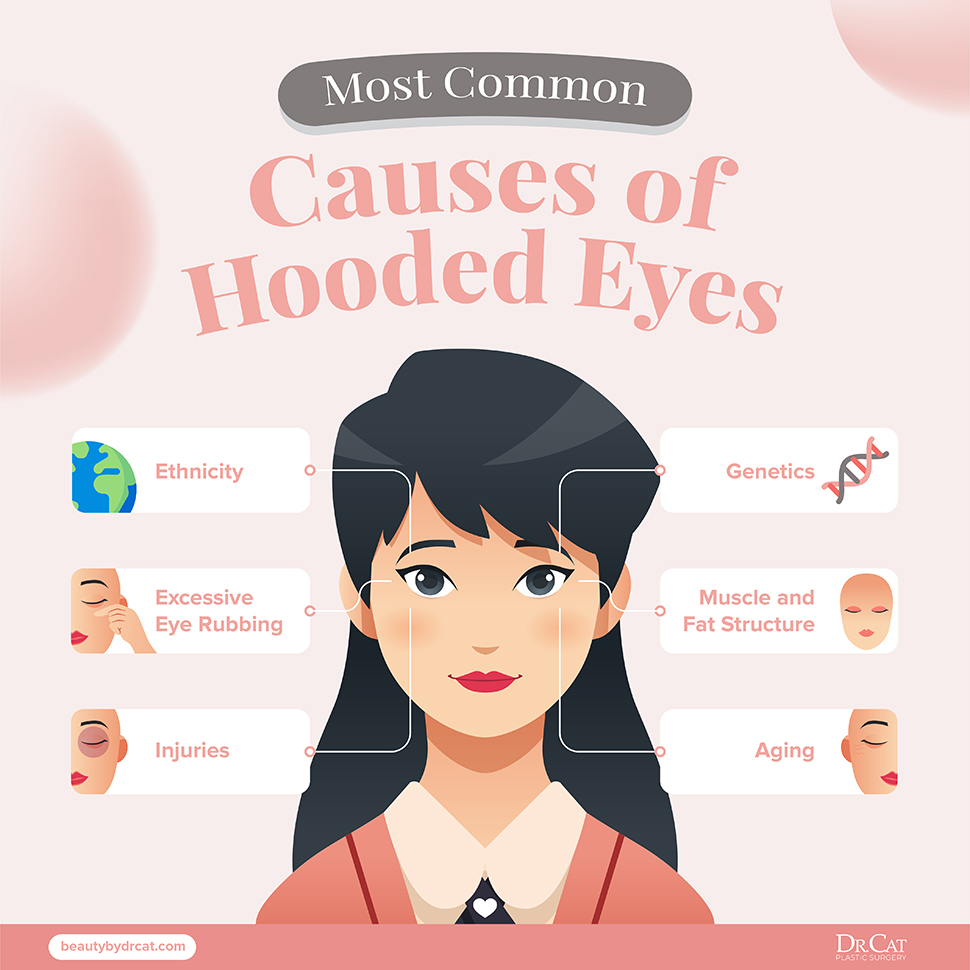
Multiple factors can contribute to the development of hooded eyes. Some of the most common causes include:
- Genetics: Many people who have hooded eyes were born with this trait. It is the natural shape of the eye. If the parents have hooded eyes, then there’s a high possibility that the children will inherit them as well. But this trait isn’t always passed on to the children.
- Ethnicity: Hooded eyes tend to be more common in people of Asian descent. But this condition can affect people of all ethnicities.
- Aging: The older you get, the more the skin starts to lose elasticity. Eventually, the loss of collagen causes the skin to sag and droop. In the eye area, it can start to droop over the upper eyelid, resulting in hooded eyes because you can no longer see the crease. Due to age, people born without hooded eyes can develop this condition later in life.
- Muscle and Fat Structure: Under the skin, the composition of the fat and muscle will affect the way the skin droops down. If the muscles are undefined or there is excess fat in the eye area, it can increase the risk of hooded eyes.
- Excessive Eye Rubbing: The skin around the eyes is very delicate, which means it can be affected by rubbing or irritating it. Be careful to avoid over-rubbing the eyes since it can increase the risk of hooded eyes and droopy eyes.
- Trauma: Different types of injuries or even medical treatments can affect the way the skin is sitting over the eye, which can change the appearance of the face. For example, a head injury can affect the eyes and surrounding skin.
Is It Necessary to Seek Treatment for Hooded Eyes?
Hooded eyes are normal and natural, so treatment isn’t necessary for this condition.
Even though treatment isn’t necessary, some people choose to schedule surgery to get rid of the excess skin. The motivation to have surgery is often for cosmetic purposes because lifting the skin can create a more youthful appearance.
Or some people choose eyelid surgery for functional reasons. The surgery might be recommended when the skin is drooping low enough to interfere with a person’s vision.
Are Hooded Eyes Beautiful?
When you read about hooded eyes, it might sound like this characteristic is unattractive or negative. But the truth is that there are many different eye shapes and types. Hooded eyes can be both beautiful and natural.
In fact, there are many famous celebrities with hooded eyes:
- Taylor Swift
- Jennifer Lawrence
- Brad Pitt
- Emma Stone
- Blake Lively
- Tom Cruise
- Camilla Belle
- Gabrielle Union
- Chris Hemsworth
- Justin Timberlake
- Samira Wiley
Some people find hooded eyes to be attractive. This feature is sometimes known as “come-to-bed eyes.”
Why Correct Hooded Eyes
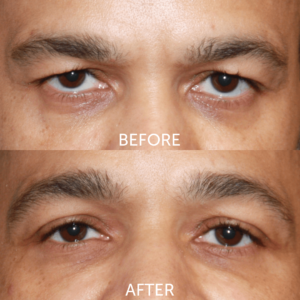
It’s been said that the eyes are the “window to the soul.” If the upper eyelid is hooded or droopy, then it could have a negative impact on your overall appearance.
Often, sagging above the eyes causes a person to look tired. Even if you are getting enough sleep, the hanging skin can affect how refreshed your eyes look.
Also, it’s common for hooded or drooping eyes to make a person look older than their age. If you are trying to maintain a youthful appearance, fixing hooded eyes could be an important step in your treatment plan.
Non-Surgical Treatment Options for Hooded Eyes
Do you want to improve the appearance of your eyes without scheduling surgery? Then one of these non-surgical methods might be a good fit:
Injectables
One potential treatment for hooded eyes is to use injectables such as dermal fillers or Botox. These treatments make a difference because they lift the eyebrow, which can be beneficial when someone experiences a slight drooping in their eyebrow and lid.
Fillers are helpful because they inject ingredients that add volume, naturally lifting the targeted area. Most fillers contain natural substances such as collagen, hyaluronic acid, or both.
Botox comes from Clostridium botulinum, deriving a toxin from this bacterium. This injection helps by paralyzing the muscles, which changes the way the skin sits over the muscles.
While the results from injectables are relatively fast, this treatment is temporary. Follow-up appointments will be needed every 3 – 6 months to maintain the results.
Eye Lift Creams
Many skincare products claim to offer results that firm and tighten the skin. If you are going to use these products around the eyes, then make sure you buy a cream formulated for the eyes specifically. Since the eyes are sensitive, certain ingredients shouldn’t be placed so close to the eyes.
The benefit of eye creams is that they help by tightening and hydrating the skin, making the eyes look more youthful and refreshed.
But eye cream doesn’t deliver the same results you can get through other treatments. So, it’s not a standalone treatment for droopy or hooded eyes.
Eye Drops
The FDA has approved one type of eye drop for improving hooded eyes: Upneeq. These eyedrops are different from lubricating drops that you buy at the drugstore.
The active ingredient in these eyedrops offers temporary results to improve droopy eyelids. When the drops are used, it causes the upper eyelid to contract and tighten.
ThermiSmooth Therapy
Aesthetic treatments like ThermiSmooth can target the skin around the eyes using radiofrequency technology. When the skin is treated with radiofrequency, it helps to boost collagen production.
The result of increased collagen is that the skin can become firmer and taut. It usually takes a few 4-10 weeks for the collagen to build to its peak, so the full results aren’t noticed immediately.
Thread Lift
Dissolvable threads can be placed in targeted areas of the face, helping to lift and tighten sagging skin. For hooded eyes, the threads can be placed in the temple area to target the skin that hangs over the eyes.
Makeup Tricks
The way eye makeup is applied can affect the appearance of hooded eyes. The goal is to maximize lid space so they appear less “hooded.”
It can be a challenge to apply makeup correctly to achieve this result. Many celebrities with hooded eyes have professional makeup artists that understand how to use this makeup trick.
The use of eyeshadow, eyeliner, and mascara can make the eyes look bigger. With the right application, it creates the illusion that excess skin is less noticeable.
Additionally, different types of cosmetic tapes and glue can be used under the makeup to help hold up the skin.
Surgical Treatment for Hooded Eyes
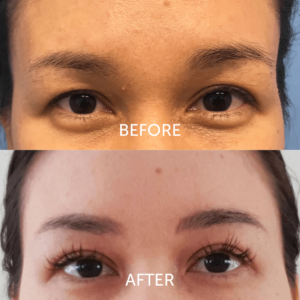 Blepharoplasty, also known as eyelid surgery, is a surgical treatment that can improve the look and function of the eyelids. The doctor removes excess fat and skin from the eyes during the surgery.
Blepharoplasty, also known as eyelid surgery, is a surgical treatment that can improve the look and function of the eyelids. The doctor removes excess fat and skin from the eyes during the surgery.
You will be under general or local anesthesia during the treatment, so you won’t feel the surgical procedure.
Potential Risks from Eyelid Surgery
Keep in mind there are always potential risks when undergoing surgery. If you are considering this treatment for cosmetic or other purposes, then make sure to talk to your doctor about the possible risks and potential outcomes you can expect.
Many patients have a successful outcome from this treatment without any complications. There is always a bit of recovery after the treatment, and symptoms often include pain, bruising, and localized swelling. But as the body heals from the surgery, these symptoms start to subside with time.
In rare cases, moderate or more severe complications, like hematoma, blurry vision, and/or scarring, might occur.
You need to know about these potential risks before scheduling the surgery so you understand the potential outcome of this treatment.
What to Expect: Recovery After Eyelid Surgery
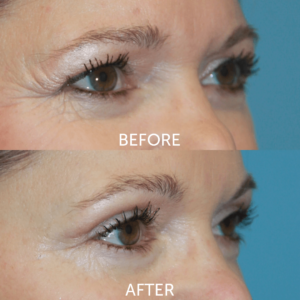 If you decide to proceed with eye surgery, you must plan your schedule to allow for healing and recovery time after the treatment.
If you decide to proceed with eye surgery, you must plan your schedule to allow for healing and recovery time after the treatment.
You will notice temporary side effects and symptoms after the surgery, such as:
- Light sensitivity
- Discomfort or pain
- Blurred vision (because of the use of lubricating ointment)
- Double vision
- Bruising
- Swelling
- Puffiness
- Numbness
- Watery eyes
Some people compare the post-op appearance to having a black eye.
It’s essential that you have someone available to drive you home after the surgery because you won’t be able to drive on your own. Additionally, many people find it beneficial to have ongoing help during recovery as their eyes are healing.
Timeline for Recovery
Typically, the bruising will disappear within the first 2 – 3 weeks. Swelling also starts to decrease, although the swelling can last for as long as 8 weeks, depending on the patient. It is a gradual healing process, so it’s essential to be patient with your progress and continue following recommended recovery steps.
Many people can return to work within 5 – 10 days, although there may still be signs of swelling and bruising. The best way to determine when you can return to regular activities is when you are comfortable enough to do the required tasks.
Tips for Recovery
It’s essential that you follow all of the doctor’s recommendations to help your eyelids recover optimally after surgery.
- Schedule Time to Recover: Plan to take time off from your daily activities, including school, work, and childcaring/household tasks. For example, you might need to schedule time off from work or coordinate with others who can help carpool the kids back and forth to school.
- Manage Swelling and Pain: The doctor will offer specific recommendations to manage your pain and swelling. Ice packs can be placed over the eyes and should be used frequently during the first three days. Also, you can take anti-inflammatory and pain-reducing over-the-counter medications.
- Don’t Rub Your Eyes: Allow the eyelids to heal. Be careful not to rub your eyes. It’s important to avoid rubbing while you are sleeping.
- Cleanliness and Contact Lenses: Be gentle while cleaning your eyelids. Don’t use contact lenses for two weeks after the surgery. Use the prescribed ointments and eye drops that your doctor recommended.

Talk to a Cosmetic Surgeon About Eyelid Treatments
Are you considering cosmetic surgery to lift your eyelids? Then consult with a local expert: Dr. Cat Begovic. Dr. Cat is a well-known and board-certified surgeon with decades of experience in the industry. Call at your convenience to schedule a consultation.
